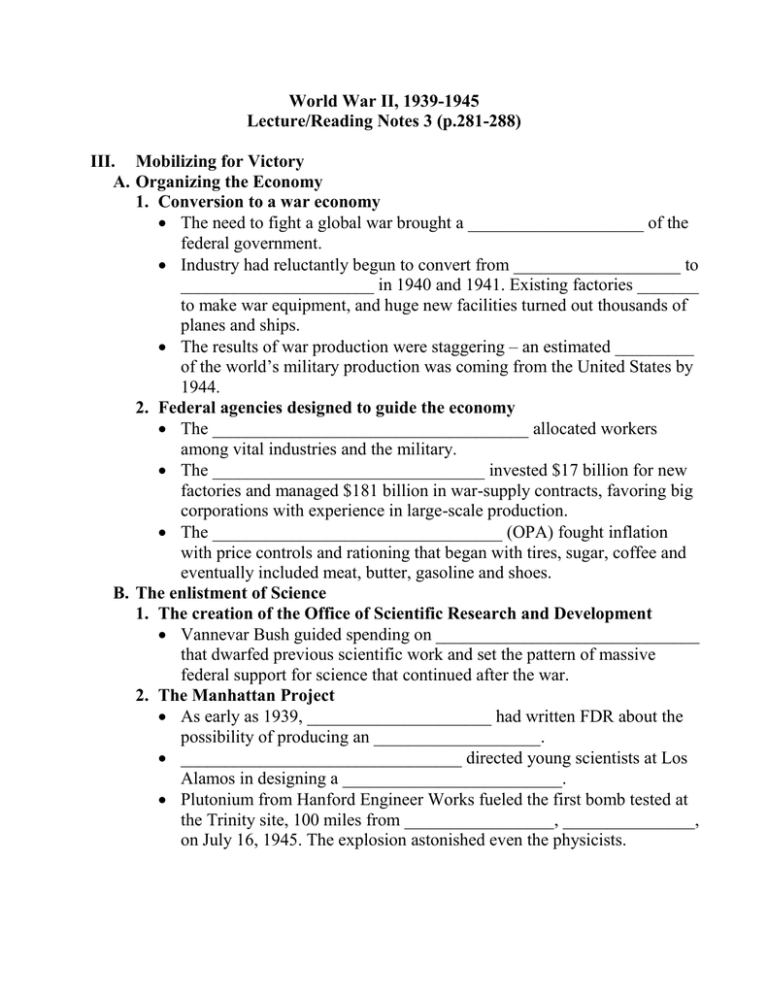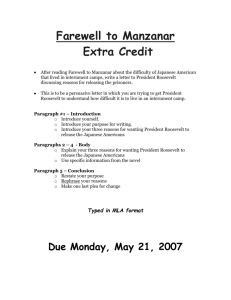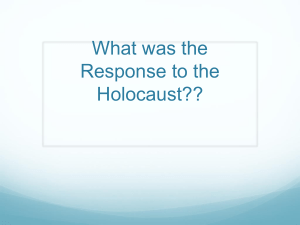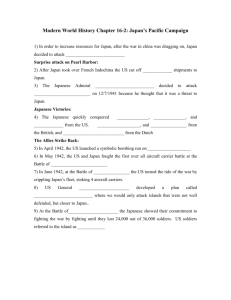World War II, 1939-1945 Lecture/Reading Notes 3 (p.281-288)
advertisement

World War II, 1939-1945 Lecture/Reading Notes 3 (p.281-288) III. Mobilizing for Victory A. Organizing the Economy 1. Conversion to a war economy The need to fight a global war brought a ____________________ of the federal government. Industry had reluctantly begun to convert from ___________________ to ______________________ in 1940 and 1941. Existing factories _______ to make war equipment, and huge new facilities turned out thousands of planes and ships. The results of war production were staggering – an estimated _________ of the world’s military production was coming from the United States by 1944. 2. Federal agencies designed to guide the economy The ____________________________________ allocated workers among vital industries and the military. The _______________________________ invested $17 billion for new factories and managed $181 billion in war-supply contracts, favoring big corporations with experience in large-scale production. The _________________________________ (OPA) fought inflation with price controls and rationing that began with tires, sugar, coffee and eventually included meat, butter, gasoline and shoes. B. The enlistment of Science 1. The creation of the Office of Scientific Research and Development Vannevar Bush guided spending on ______________________________ that dwarfed previous scientific work and set the pattern of massive federal support for science that continued after the war. 2. The Manhattan Project As early as 1939, _____________________ had written FDR about the possibility of producing an ___________________. ________________________________ directed young scientists at Los Alamos in designing a _________________________. Plutonium from Hanford Engineer Works fueled the first bomb tested at the Trinity site, 100 miles from _________________, _______________, on July 16, 1945. The explosion astonished even the physicists. C. Men and Women in the Military 1. American Indians ______________________ American Indians served in the armed forces, most in racially integrated units. More than three hundred Navajo were “_____________________” who served in the Pacific theater. 2. African Americans Approximately _______________ African Americans also served in the armed forces during World War II. As it had since the Civil War, the army organized black soldiers in __________________________ and often assigned them to the more menial jobs, __________________________________ until manpower shortages forced changes in this policy. The war experience helped to invigorate postwar efforts to ___________ ______________, as had also been true after World War I. 3. Women The nation had a different – ___________________ – reaction to the women who joined the armed forces. Many of the women in uniform hammered at _________________, worked ___________________, _______________________. Others, however, worked close to combat zones as photographers, code analysts, and nurses. The greatest departure from expected roles was the work of the 1,074 members of the _____________________________________(WASPS), a civilian auxiliary of the U.S. Army Air Forces. D. The Home Front 1. Families in wartime Americans put their __________________________. Couples who had postponed marriage because of the depression could ________________ as the economy picked up. The draft started with _______________, then called up _____________ without children, and finally tapped ______________ in 1943. Left at home were millions of “service wives,” whose compensation from the government was $50 per month. 2. War propaganda and censorship The federal government tried to keep civilians of all ages committed to the war. It encouraged _____________ and backyard _______________. The government also managed news ______________________. Censors screened soldiers’ ______________. Early in the war, they blocked publication of most photographs of ____________________. Censors also authorized photographs of enemy atrocities to motivate the public. The Office of War Information wanted ____________________ in feature films, but not so heavy-handed that it drove viewers from the theaters. The most successful films dramatized the heroism of the __________. E. New Workers 1. Women in the workforce As draft calls took men off the ____________________, women changed the composition of the industrial work force. The war gave them new job opportunities that were embodied in the image of __________________. By 1944, fully 19 million women held paid jobs, up 6 million in four years. Women’s share of government jobs increased from ____________ percent and their share of manufacturing jobs from ___________ percent. 2. Mexican –American labor As defense factories and the military absorbed workers, western farms and railroads faced an acute _________________________. In 1942, the United States and Mexico negotiated the _______________, under which the Mexican government recruited workers to come to the United States on six-to-twelve month contracts. 3. The assimilation of Native Americans The war was a powerful force for the assimilation of Native Americans. ____________________ moved to off-reservation jobs; they were a key labor force for military supply depots throughout the West. The average cash income of Indian households ________ during the war. Congress had made Indians citizens in 1924, but several states continued to ___________________________________. Activists organized the National Congress of American Indians in 1944 and began the efforts that led to the U.S. Supreme Court in 1948 to require states to _______________________. 4. The Fair Employment Practices Committee To head off a major embarrassment, Roosevelt issued Executive Order 8802 in June 1941____________________________ in defense contracts and creating the Fair Employment Practices Committee. But white resistance to black coworkers remained strong. Nevertheless, African-American membership in labor unions _____________, and wartime prosperity raised the average black income from ____________ of the white average in 1939 to _______________by 1950. F. Clashing Cultures White Southerners and black Northerners with different ideas of racial etiquette found themselves side by side in _______________________. In the Midwest, black migrants from the South and white migrants from Appalachia completed for the same _____________________ and scarce apartments. Tensions between black and white residents exploded in at least _______ _________ in 1943 alone. G. The Internment of Japanese Americans On February 19, 1942, President Roosevelt issued Executive Order 9066, which authorized the secretary of war to define restricted areas and ____________________________ who were threats to national security. The primary targets were ________________________________ in California and parts of Washington, Oregon, and Arizona. At the end of April 1942, Japanese in the coastal states were given a _________________________________ and report to assembly centers, where they were housed before being moved to ten _________________ in isolated locations in the western interior. Here they were housed in tarpaper barracks, hemmed in by _____________________, and guarded by military police. Hawaii treated Japanese Americans much differently. Less than _______ Hawaii’s Japanese American population of 160,000 was interned. H. The End of the New Deal 1. A conservative Congress in 1942 After the 1942 election left Congress in the hands of Republicans, conservative lawmakers ignored proposals that war emergency housing be used to improve the nation’s permanent housing stock, abolished the _____________________________, curtailed rural electrification, and crippled the ____________________________________. 2. The election of 1944 The Republicans nominated Governor ______________________ of New York and the Democrats renominated Roosevelt for a fourth term. Voters gave Roosevelt 432 electoral votes to 99, but the narrowing gap in the popular vote – ____________ for Roosevelt and _____________ for Dewey – made the Republicans eager for 1948.





